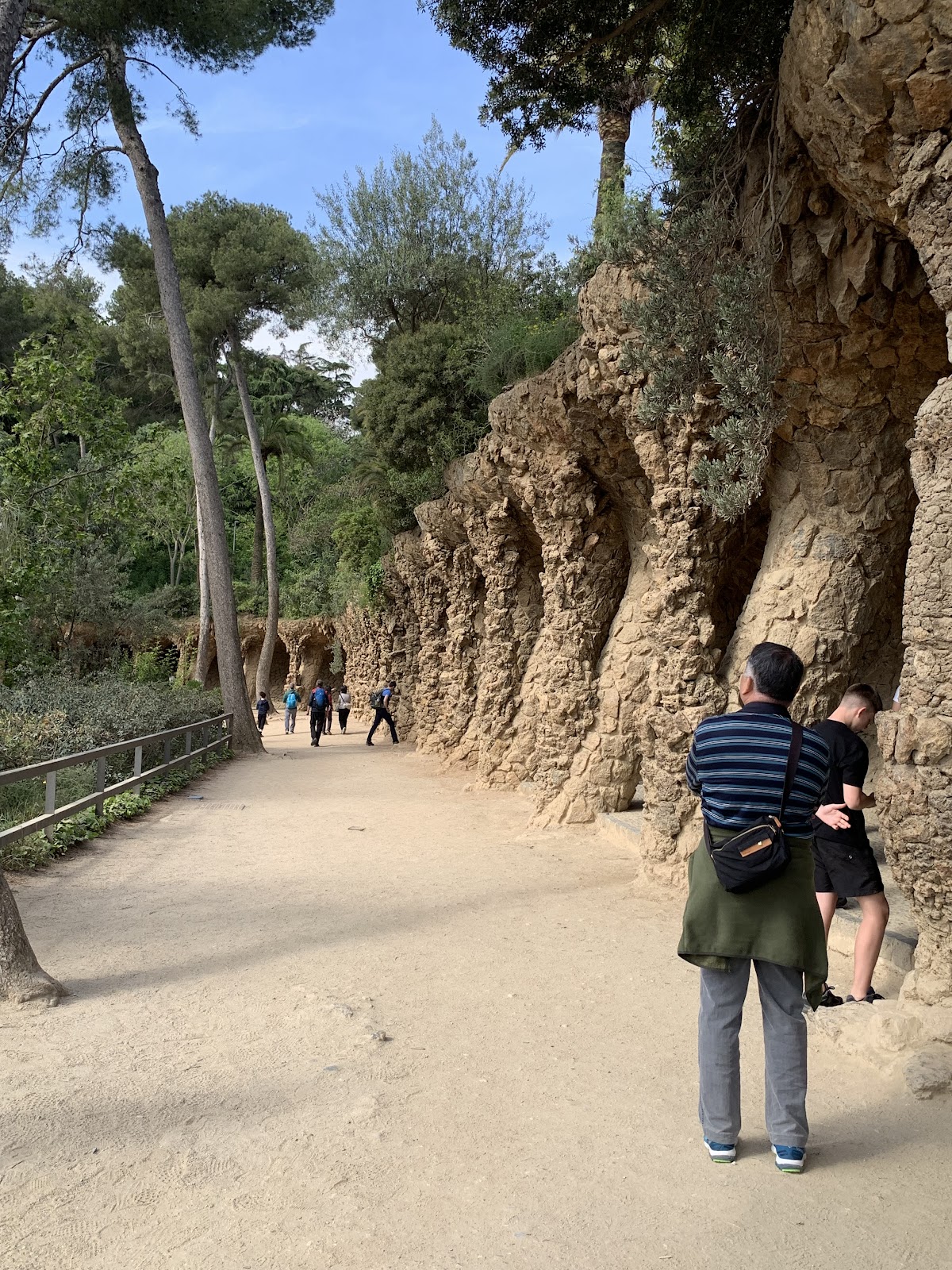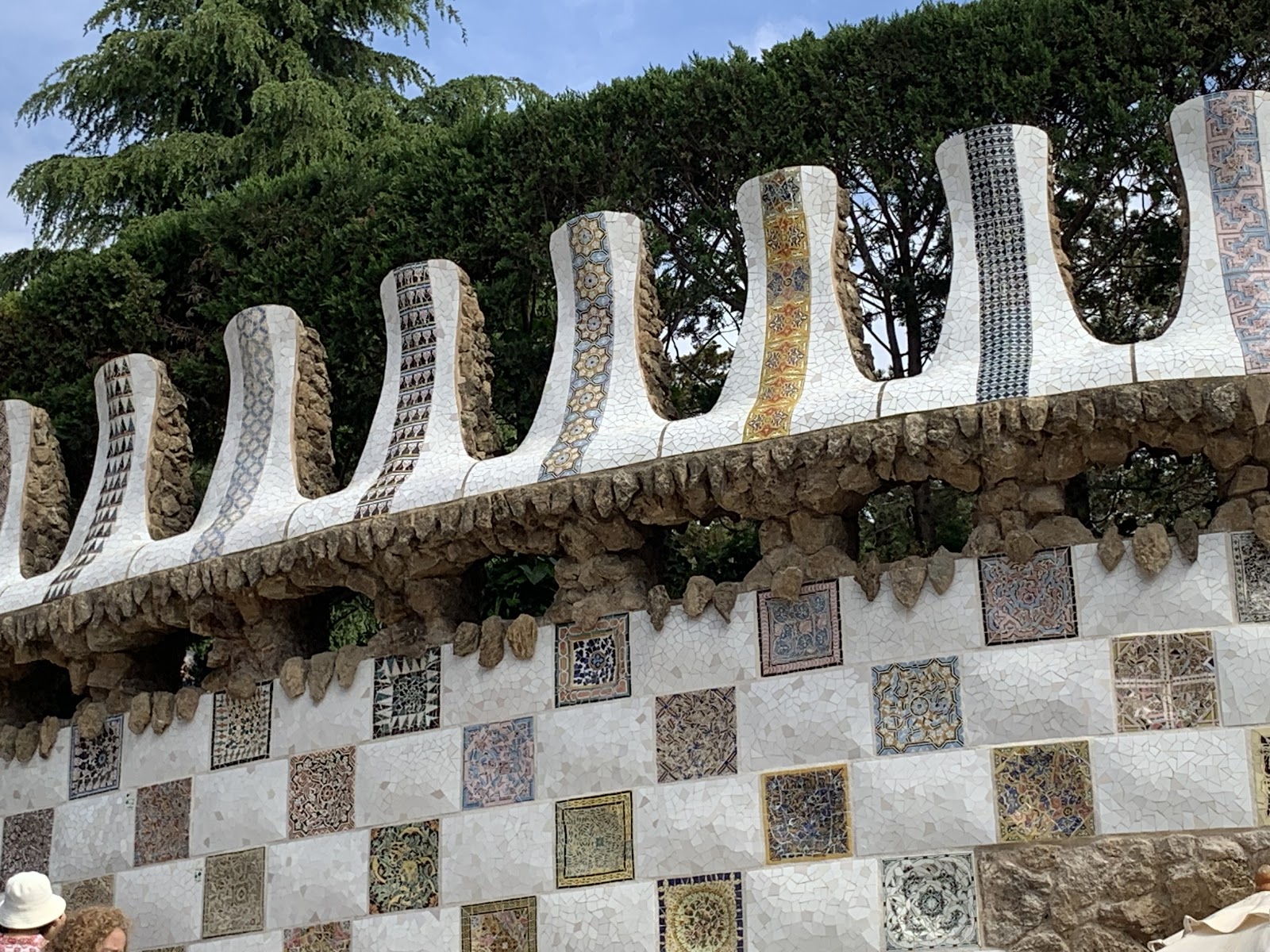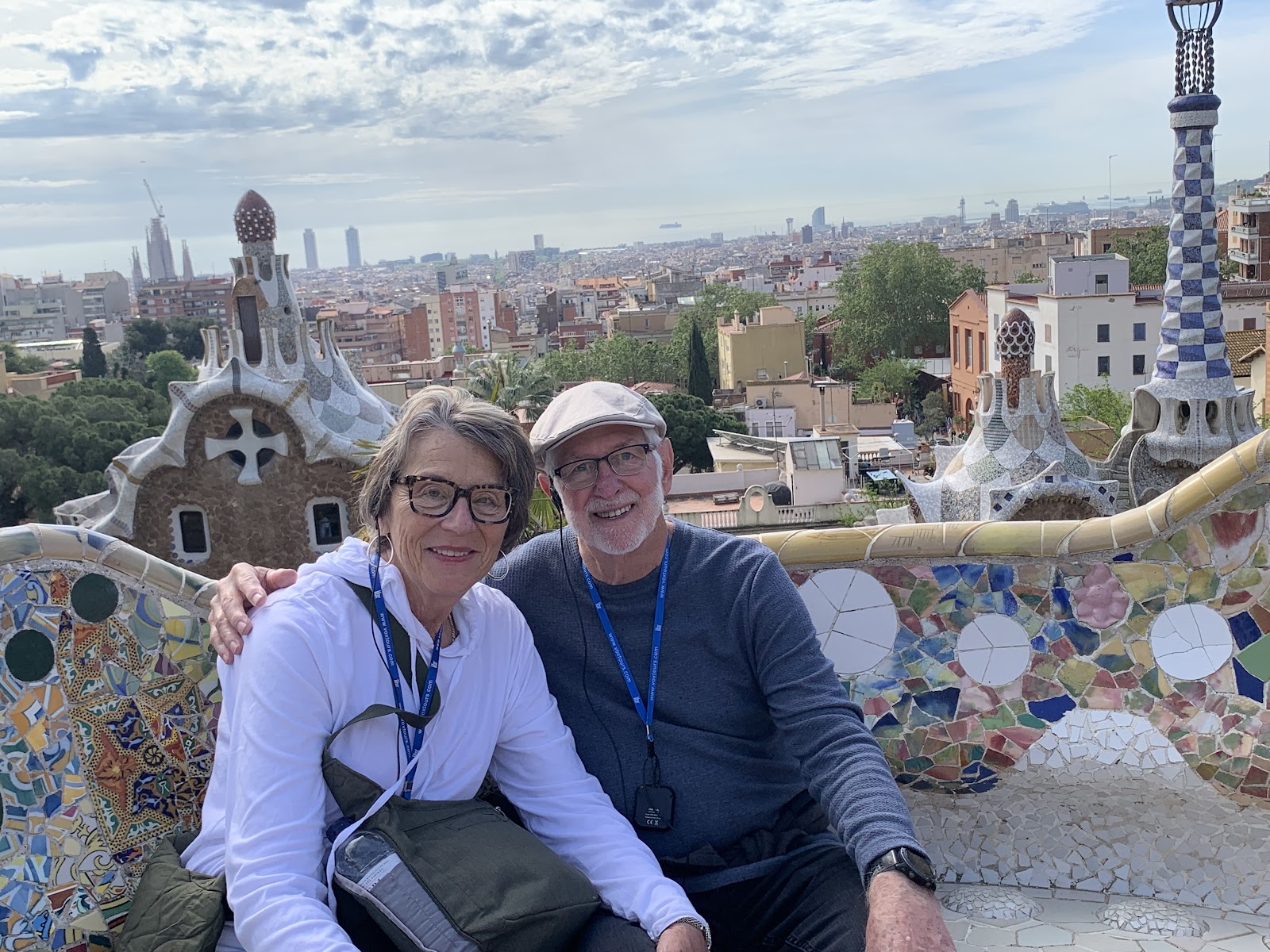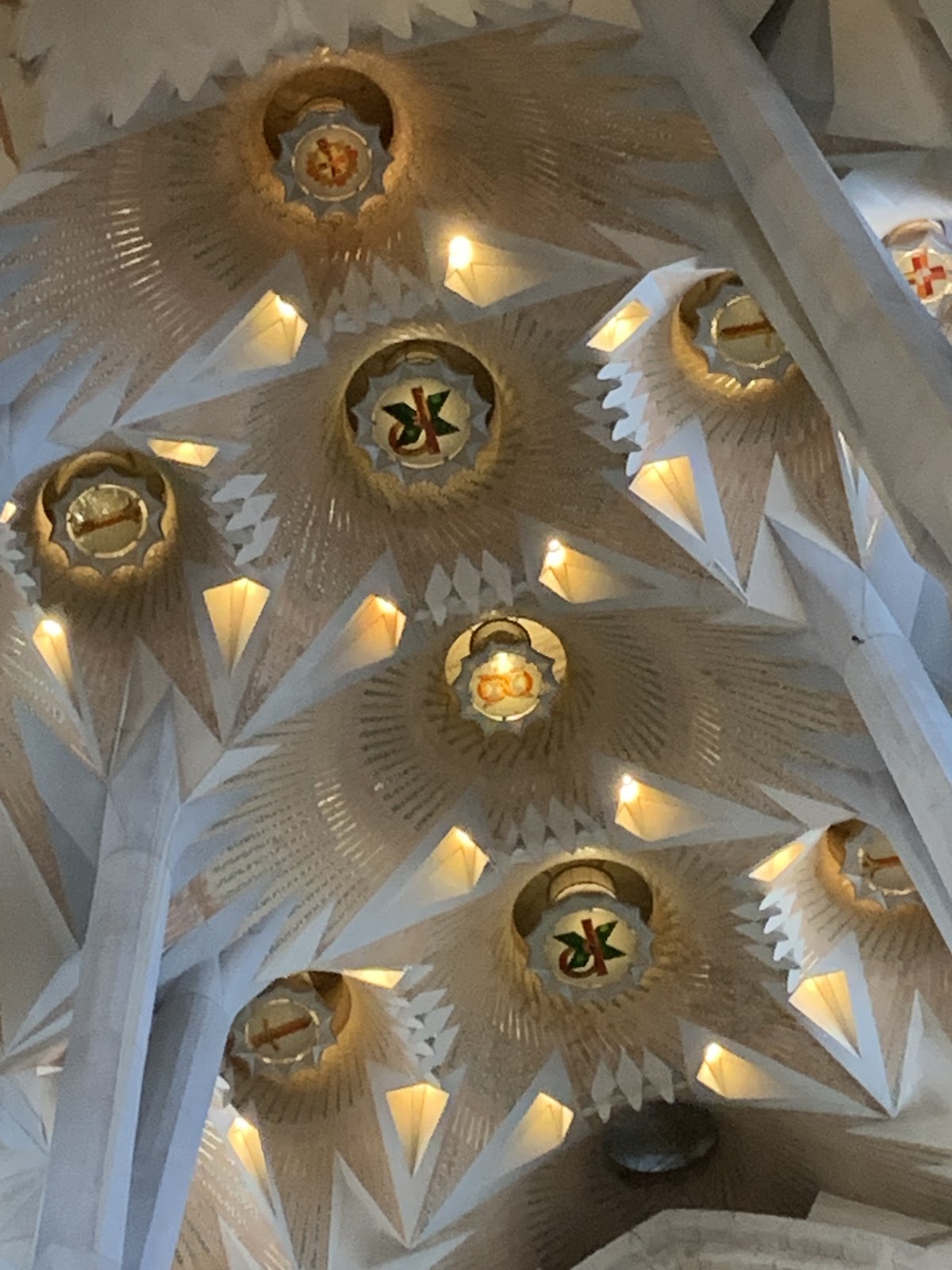Antoni Guadi’s Barcelona as seen through the eyes of two Gringos!
Checking into our hotel in Barcelona, a mere 200 meters from the train station, we saw this behind the counter. The word of the day, wanderlust, describes us.
Sometimes you feel like a city is defined by one person and for Barcelona, that seems to be Antoni Gaudi. He was an architect, born in 1882. This was the same year as Malcolm’s grandfather.
In 1912, at the age of 30, and relatively unknown, he was commissioned by a wealthy Barcelonan to build an apartment building. Today, his work in Barcelona is still going on. He died in 1926, but his work continues in the non-stop building of the Sagrada Familia.
Our first venture into Gaudi’s world was while walking up the stairs from the subway station. We turned around to face Casa Milá. In every blink of the eye, you are drawn into the design. Before showing you some of his work, we’ll quote a local expert named Amanda, that we saw quoted in something we read. (We’d love to give her more precise credit, but we don’t even know her full name.)
“With Gaudi, nothing is by
coincidence. Everything has a reason, a motive. Every little detail is considered,
and nothing is left to chance”
All of his designs emanate from nature and from religion. Nature doesn’t have many sharp angles and neither did Gaudi. His use of mixed colors was obvious everywhere. From the broken tile mosaics to the walls and ceiling, color was everywhere. Light filled the rooms and the rooftops, and corners were playfully designed. Some of the roofs resembled the natural stone columns we have seen in Cappadocia. Castled turrets topped almost whimsically. Not only was it designed to be pleasant on the eye, but the shapes provided function by trapping and collecting water.
We asked about tickets to enter Casa Milá and were directed to the ticket window. When Malcolm asked about when we would go in, they said “now,” and we did. Susanne realized, it but Malcolm didn’t know that this was our first experience of cutting in line as we should have gone to the back of the queue. Se la vie! Here are some pictures of the Casa Milá.
Everything curves. There are no hard angles.
There is another Gaudi apartment building, but this was one of the only one we saw.
Gaudi was commissioned by a wealthy businessman named Guell to build an exclusive development of approximately 40 homes in an area outside of town. Gaudi designed and built Parc Guell. The development was a flop. Only one house was built when it was realized how far out this was from the city and no one was interested in buying. The Parc though, is a success. Throughout you see examples of Gaudi’s thinking and creativity in the columns holding up structures, in the building styles, and in the use of colorful mosaics and curving designs. Columns like trees. Mosaics in the ceiling to reflect the seasons. Everything with a purpose and nothing by accident.
Sagrada Familia
We arrived in Sagrada Familia on the eve of Spanish Valentine’s Day, which is St. George’s names day. The Spanish tradition is that a rose is given to the ladies and a book to the men on this day, The streets were filled with vendors for each. St. George is the patron saint of Barcelona. Our guide’s name was Jordi and he was so excited that his name’s day was going to be the following day.
Nowhere is Gaudi as present as in his cathedral, the Sagrada Familia. In the 12th through the 14th century, cathedral building was happening all across Europe. If you are interested in these cathedrals, we would suggest a reading of the book, “Pillars of the Earth.” It was one of our favorite reads before we ventured into the cathedrals of Europe. The stories were so real that we can still recall Tom, the stone mason, and we would look at each stone in each building with awe. But we never expected to see a 20th century cathedral.
Like Jimmy Buffet was a ‘...pirate, 200 years too late...,’ Gaudi was an architect, 800 years too late to build the cathedrals. But he didn’t know that, and so he built it. He managed to dedicate the last 14 years of this life to this cathedral. And his work continues on with architects and artists of every kind continuing on. It includes his ideas but incorporated others' ideas too.
The word of the day is 'energy.'
As we entered the nave of the cathedral, we felt a sense of energy that filled the room and us. The light coming through the windows. Leaning against the tree-like columns, we helped support the Gaudi designed columns that supported the roof and ceiling. We knew this was what Gaudi wanted.
One with our backs to the east and the other to the west. Your guess?
The east side of the cathedral was finished in Gaudi’s time.
He died in 1926 three days after a tragic accident in which he was struck by a
streetcar. On the east, there are traditional carvings of biblical scenes
representing the life of Christ. The towers of the structure are designed to be
like the Montserrat mountains and not the traditional spires of a cathedral.
The west side, still under construction, has seen a
different collection of 21st century artists contribute to its more
modern artistic style. The shapes are sharper, more angular and less curving
than Gaudi’s. But Gaudi always said that this was not his building and that he
would be only one contributor to this great structure. This has proven to be
true.
We have referred to this as a cathedral or basilica, because
we’re not sure what to call it. It is not a cathedral in the classical sense. We
don’t believe that most of its funding has come from the Catholic Church and
although it is a church, it is also a UNESCO World Heritage Site. The late Pope
Francis did hold mass here a few years ago. It is not the official cathedral of the arch-diocese of Barcelona. Wikipedia, describes it as the world's largest unfinished Catholic church. Correction, it was not Pope Francis, but rather Pope Benedict XVI who held mass here and consecrated the building as a Catholic Church in 2010.
We were told that 2026 is the year of completion, yet we were also told that the entrance to the facility, from the south, is still in the planning stages. If the doors were opened, less than 50 feet away is an apartment building. There are offers to relocate the apartment tenants into other apartments. Doing this and tearing down the apartment building would probably take longer than 18 months to accomplish. Imagine, you build a building in the middle of a city starting in 1912. The city grows up around you and now, you need more space. So, you must tear down the better part of a city block to accomplish this. This is even before the first stone is laid for the new entry. It is doubtful that 2026 is a reasonable date. Our guide kept explaining Spanish time to us. Jordi said that this is ‘being built on Spanish time.” And Spanish time is a difficult concept to understand. But, we already understood it by its more appropriate colloquial name of “Rugeley time!”

































We loved gaudi too on our 2 extended stays in Barcelona when Win was doing his PhD at upf... Y'all having much fun.! Hope today's power outage hasn't caused a crisis for y'all
ReplyDelete